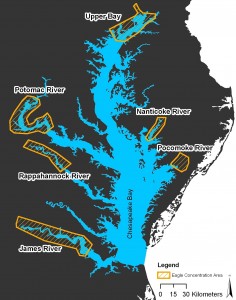Migratory Bald Eagle Populations

Eagle concentration areas (indicated by yellow hatch) in the Chesapeake Bay.
Bald eagle “concentration areas” are locations where eagles congregate in numbers much higher than what may be accounted for by local breeding pairs and their offspring and that support one to several communal roosts. Due to the status of the Chesapeake Bay as both a summer and winter destination for migrants, concentration areas may support a complex mix of individuals of different ages and from different populations. For example, during the summer months, concentration areas may support adults, sub-adults and young-of-the-year from the Chesapeake Bay population (some of which may vacate their territories after breeding to move into concentration areas) and from the Southeast. Similarly, winter concentration areas may support non-breeding birds from the Chesapeake Bay and both reproductive and non-breeding birds from the Northeast. Because of this mix, it is difficult to determine how many birds are moving into the Bay from distant source populations. An additional problem is that there has been no definitive treatment of residency times/turnover rates of birds within concentration areas. For this reason, it is not possible to infer how many different individuals may be using particular concentration areas over an extended period of time.
Summer Concentration Areas
The northward migration of bald eagles from Florida to the Chesapeake Bay was first documented during a review of band returns from the 1940s by Broley (1947). Broley showed that young birds banded in Florida as nestlings migrated north along the coast to the mid-Atlantic (or in a few instances further north). Definitive confirmation of these early findings has been obtained in recent years by Millsap et al. (2002) who used satellite telemetry to track 57 young eagles from Florida to their summer territories. Nearly 50% of these birds spent the summer in the Chesapeake Bay or coastal North Carolina. The birds returned to Florida for the winter months and established winter territories. What proportion of the southeastern populations (outside of Florida) migrate to the Bay for the summer is currently unknown. Observations of birds within several of these concentration areas implies that the migrants utilize the Bay not just as foraging areas but as a molting ground suggesting that the Bay plays an important role in their annual cycle.
Based on band returns and direct observations, Broley (1947) estimated that birds begin to leave Florida in April. This estimate was consistent with telemetry data obtained by Millsap et al. (2002). Migrant eagles appear to move into the Bay in early to mid-May. Use of concentration areas begins to rise during this period and reaches a peak between mid-June and mid-July (Watts and Byrd, unpublished data for lower Bay). In most years, numbers decline within concentration areas from mid-July through the end of September (Watts and Byrd, unpublished data for lower Bay). The timing of movements out of the Bay is consistent with Broley’s (1947) estimate from band recoveries of when birds return to Florida. Adults and sub-adults exhibit different schedules of migration and appear to have different residency periods within the Bay. Birds that move into the Bay in May are predominantly sub-adults. These birds are followed by adults such that the ratio of adults to sub-adults increases through the early summer and eventually reaches an approximate 1:1 ratio by the peak period. Age ratio shifts back toward a sub-adult bias through the early fall. Taken together, these patterns suggest that adults enter the Bay later and stay for a shorter period of time compared to sub-adults.
In general, use of summer concentration areas has not been monitored as intensively as the breeding population. Peak counts of birds using the upper James River concentration area increased by a factor of 5 between 1982 and 1991 (Watts and Byrd 1999). This level of increase is generally consistent with the growth in the populations believed to utilize the Bay during summer. Collectively, summer concentration areas within the lower Chesapeake Bay of Virginia support a minimum of 1,200 birds. This composite number is based on peak bald eagle estimates within concentration areas during the mid-1990’s from shoreline surveys. Peak counts include: James River (450), upper Rappahannock River (320), and Upper Potomac River (500+). How many total birds may pass through these areas during the summer months or what proportion of birds is from distant populations is unknown.
Winter Concentration Areas
Bald eagles from northeastern Canada and the United States migrate southward into the Chesapeake Bay and Virginia during the late fall and early winter period (Stewart and Robbins 1958, McCollough 1986, Byrd et al. 1990). These birds apparently move south in advance of large water bodies freezing over in northern latitudes and their appearance in the Bay coincides with the movement of waterfowl into the area. Numbers increase through November and December typically reaching a peak in January. Most northern birds are believed to have moved northward out of the Bay by late March.
As with summer concentration areas, winter concentration areas within the Chesapeake Bay have not been monitored with the same intensity as the breeding population. However, mid-winter surveys have been conducted in Virginia within selected concentration areas since the early 1980s. Between 1997 and 2000 the number of birds within Virginia sampling areas increased at an annual rate of 4.5% (Steenhof et al. 2002). This rate is considerably below that reported for the expected source populations. However, some specific sites have shown considerably higher increases in use than the overall state average (e.g. Portlock 1994).
